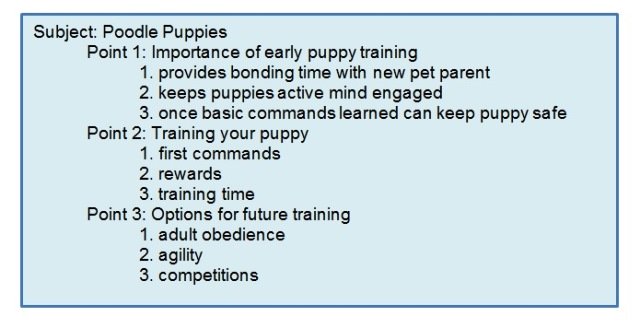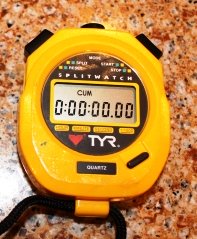7 Steps for Speech Writing Success
 |
When speech writing, sometimes starting is the most challenging task. How do you write a speech? Here are seven steps to help you with speech writing. |
Step #1 - Some things to think about ...
Before you begin, take some time to think seriously about the message you want to send to your audience. What is it you want to say?
Here are some things to think about:
- What exactly do you want to say?
- What does your audience expect to hear?
- Who is your audience?
- How much time do you have to give your speech--five minutes or two hours?
- What does your audience want to hear? (This one is SUPER important.)
Also, think about what you want them to remember from your talk AND how you want them to remember you. Then jot down some ideas ... what I call pre-writing. Ponder those ideas for a day or two (if you have the time--30 minutes, if you don't). Then move to step #2.
Step #2 - The 3-Point Outline
I use outlines all the time when I'm speech writing. An outline is simply bullet points of information that briefly and generally tell what you plan to say. It's a way to help you organize your thoughts.
I suggest using three main bullet points with three sub-points for each main bullet point. (If you have a longer speech, then you'll probably want to have more bullet points.) The important thing to remember is to be consistent with your message and how you organize it.
One reason for using bullet points is when you get nervous (and you will, if you care--and I know you do), it is easier to remember you have X number of things to say. Three is an easy number to remember, which is why I suggest having just three main points. Then you can mentally check them off in your brain as you speak.
For each of the three main points, you'll also have sub-points. I suggest having just three sub-points as well. However, if you have a longer speech, you may need more, and that's okay. Just remember that number, and use that to do a mental checklist as you talk.
For example, let’s say you're giving a speech about dogs, specifically puppy training. And, let's pretend your audience will be a poodle club full of poodle lovers. Here's a sample bullet point outline of the speech:
Subject/topic: Poodle Puppy Training
Audience: Poodle Club Members and Guests (i.e. Poodle lovers)
Main Point 1: Importance of early puppy training
Main Point 2: Training your puppy
Main Point 3: Options for future training
Once you have a general outline of main bullet points (like I've shown above), then you can break down each main point into the things you plan to talk about more specifically (those are the sub-points). Here's an example of how your outline would look now:

Once you break it down into sub-points, you can break it down further if you need to. When you're finished with the outline, you can move to step #3 and begin writing a rough draft of the speech.
Looking for more speech writing help?
Here's help for other types of speeches people may need to give.
- How to write a speech: 5 Tips when you need a speech NOW!
- How to write a eulogy
- How to write an address
- How to write a sermon
- Wedding speech writing ideas
- 40th Birthday speech writing ideas
- How to write an appreciation speech
- How to write a welcome speech
- How to write a script
- Even MORE speech writing tips ...
Step #3 - Speech Writing Rough Draft
Now it's time to write out the speech.
Yes, you'll take out a piece of paper or open a new MS Word document, and write a rough draft of what you plan to say. Think of how you'll begin ... how will you transition from the opening to bullet point number one, and so forth?
The outline makes it is easy to stay focused when writing the rough draft of your speech.
I like to write the whole speech out using the outline--before I practice speaking it. I also write it in the way I would say it to my audience.
What’s important to think about is the pauses. If you write a speech the way you’d write a report for school, then you’d have too many sentences that are way too long and way too cumbersome to speak aloud.
Use sentence variety to break up the paragraph and make your speech writing sound like the way you talk. (In other words, write the way you speak, not the way your English teacher taught you how to write a report for school.)
Step #4 - Read Your Speech Aloud--WITH a Timer!

After speech writing, scroll to the beginning of the page (if you wrote it on your computer) or flip back to the beginning of your speech (if you wrote it in a notebook). Set your watch or timer. Stand up. Take a deep breath. And, read your speech aloud. Like you would when you say it to your audience.
How does it read? Is it smooth? Or, do you stumble through the words?
If you’re stumbling, then re-write those parts.
Think about how long it took to read your speech the way you'd say it to your audience. Was it too short or too long for your allotted time? If it’s too short, then add more. If too long, take some out.
Step #5 - Throw away the speech.
Yes, you read that correctly. I said, throw it away.
Or, “X” out of your computer ... or crumple up your speech. But, the bottom line is to get the speech out of your eye sight!
Daniel Lapin, author of one of my favorite books, Thou Shalt Prosper, shares a story about how as a young boy his dad ripped up and threw his speech notes out the car window ... as they drove to the venue where he would give his first big speech.
Talk about panicking before giving your speech!
In the end, his father pulled over and practiced the speech with him. And, the speech was a success.
The point is, you know what you want to say. Just say it.
Using notes discredits you. Why? Because, you'll be looking at them and reading from them during the whole speech ... And, your audience won’t think you are as professional as you'd want them to believe.
Why? Because, reading from or looking at your notes often says you don't know the material you're speaking about ... and it looks unprofessional.
May be you say you're not a professional?
Okay. Are you speaking only in front of friends or family? Fine.
But, I’m sure you want to look eloquent, like you know how to communicate well. And, like you're well prepared. Right?
I mean, you don’t want pitty, “good jobs.” You want sincere ones.
So, get rid of your written speech or notes--and move on to step #6.
Step #6 - Practice in your closet.
Closets are perfect for practicing your speech aloud.
You can speak at a normal volume, because the clothing and other things you stuff in there act as insulation from the outside world.
It’s a place where people can’t hear you too much.
And, I suggest practicing for about an hour or two at a time. Then take a break.
If you have the time, I'd suggest spending two hours a day for a week practicing.
I also suggest recording yourself with a handheld recorder during one of your closet practice sessions. And, play it back. (It's painful, I know.) Then work to correct any annoying ticks (like "ums" or mouth noises we do with our tongues as we speak).
If you do this, you’ll know that speech well and nail it come speech time!
Step # 7 - Practice in front of real people.
When I was learning how to write a speech, there came a point when I realized I had to give it. That can be more scary than speech writing!
One of the best places to practice speaking is at a Toastmasters meeting. If you’re not a member, you can set up your living room and present your speech to your family or friends.
Sometimes, I don’t like to give "practice" speeches in front of family. Sometimes they are a bit too critical or too nice--or "helpful"-- and it hurts me rather than helps me.
So, if there is a club or church gathering or some other small meeting where you can present your speech to real people, that’s another way to practice and maybe get some feedback.
You may not like what you hear, but often that’s what you need to hear to get better.
Speaking is more difficult than speech writing.
Often we are called to do something new at the most terrible times.
May be you’re asked to give an address at work or a eulogy. May be you’re going to school to become a pastor learning to write a sermon. Or, maybe your best friend is getting married and you just want to write a good toast.
Emotions help us with speech writing and giving. So, don’t be afraid to show them!
And lastly, the more you speak in front of people, the easier it will be. Although, I understand it is much easier to be an audience member than to be the speaker!
Advertisement:
Advertisement:







